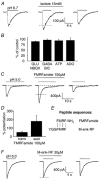Modulation of ASIC channels in rat cerebellar Purkinje neurons by ischaemia-related signals
- PMID: 12205186
- PMCID: PMC2290513
- DOI: 10.1113/jphysiol.2002.020297
Modulation of ASIC channels in rat cerebellar Purkinje neurons by ischaemia-related signals
Abstract
Acid-sensing ion channels (ASICs), activated by a decrease of extracellular pH, are found in neurons throughout the nervous system. They have an amino acid sequence similar to that of ion channels activated by membrane stretch, and have been implicated in touch sensation. Here we characterize the pH-dependent activation of ASICs in cerebellar Purkinje cells and investigate how they are modulated by factors released in ischaemia. Lowering the external pH from 7.4 activated an inward current at -66 mV, carried largely by Na+ ions, which was half-maximal for a step to pH 6.4 and was blocked by amiloride and gadolinium. The H+-gated current desensitized within a few seconds, but approximately 30 % of cells showed a sustained inward current (11 % of the peak current) in response to the maintained presence of pH 6 solution. The peak H+-evoked current was potentiated by membrane stretch (which occurs in ischaemia when [K+]o rises) and by arachidonic acid (which is released when [Ca2+]i rises in ischaemia). Arachidonic acid increased to 77 % the fraction of cells showing a sustained current evoked by acid pH. The ASIC currents were also potentiated by lactate (which is released when metabolism becomes anaerobic in ischaemia) and by FMRFamide (which may mimic the action of related mammalian RFamide transmitters). These data reinforce suggestions of a mechanosensory aspect to ASIC channel function, and show that the activation of ASICs reflects the integration of multiple signals which are present during ischaemia.
Figures




Similar articles
-
Arachidonic acid potentiates acid-sensing ion channels in rat sensory neurons by a direct action.Neuroscience. 2007 Mar 16;145(2):686-98. doi: 10.1016/j.neuroscience.2006.12.024. Epub 2007 Jan 29. Neuroscience. 2007. PMID: 17258862
-
Acid-sensing ion channels contribute to transduction of extracellular acidosis in rat carotid body glomus cells.Circ Res. 2007 Nov 9;101(10):1009-19. doi: 10.1161/CIRCRESAHA.107.154377. Epub 2007 Sep 13. Circ Res. 2007. PMID: 17872465
-
Endomorphins potentiate acid-sensing ion channel currents and enhance the lactic acid-mediated increase in arterial blood pressure: effects amplified in hindlimb ischaemia.J Physiol. 2017 Dec 1;595(23):7167-7183. doi: 10.1113/JP275058. Epub 2017 Nov 9. J Physiol. 2017. PMID: 29044528 Free PMC article.
-
Ca2+ -permeable acid-sensing ion channels and ischemic brain injury.J Membr Biol. 2006 Jan;209(1):59-68. doi: 10.1007/s00232-005-0840-x. Epub 2006 Apr 17. J Membr Biol. 2006. PMID: 16685601 Review.
-
FMRFamide-gated sodium channel and ASIC channels: a new class of ionotropic receptors for FMRFamide and related peptides.Peptides. 2006 May;27(5):1138-52. doi: 10.1016/j.peptides.2005.06.037. Epub 2006 Mar 3. Peptides. 2006. PMID: 16516345 Review.
Cited by
-
Overexpression of acid-sensing ion channel 1a in transgenic mice increases acquired fear-related behavior.Proc Natl Acad Sci U S A. 2004 Mar 9;101(10):3621-6. doi: 10.1073/pnas.0308753101. Epub 2004 Feb 26. Proc Natl Acad Sci U S A. 2004. PMID: 14988500 Free PMC article.
-
Extracellular chloride modulates the desensitization kinetics of acid-sensing ion channel 1a (ASIC1a).J Biol Chem. 2010 Jun 4;285(23):17425-31. doi: 10.1074/jbc.M109.091561. Epub 2010 Apr 12. J Biol Chem. 2010. PMID: 20385551 Free PMC article.
-
Multiscale molecular dynamics simulations predict arachidonic acid binding sites in human ASIC1a and ASIC3 transmembrane domains.J Gen Physiol. 2023 Mar 6;155(3):e202213259. doi: 10.1085/jgp.202213259. Epub 2023 Jan 10. J Gen Physiol. 2023. PMID: 36625864 Free PMC article.
-
Calcium-permeable ion channels involved in glutamate receptor-independent ischemic brain injury.Acta Pharmacol Sin. 2011 Jun;32(6):734-40. doi: 10.1038/aps.2011.47. Epub 2011 May 9. Acta Pharmacol Sin. 2011. PMID: 21552295 Free PMC article. Review.
-
Disruption of ion homeostasis in the neurogliovascular unit underlies the pathogenesis of ischemic cerebral edema.Transl Stroke Res. 2014 Feb;5(1):3-16. doi: 10.1007/s12975-013-0307-9. Epub 2013 Nov 22. Transl Stroke Res. 2014. PMID: 24323726 Free PMC article. Review.
References
-
- Akaike N, Ueno S. Proton-induced current in neuronal cells. Progress in Neurobiology. 1994;43:73–83. - PubMed
-
- Askwith CC, Cheng C, Ikuma M, Benson C, Price MP, Welsh MJ. Neuropeptide FF and FMRFamide potentiate acid-evoked currents from sensory neurons and proton-gated channels. Neuron. 2000;26:133–141. - PubMed
-
- Babinski K, Catarsi S, Biagini G, Seguela P. Mammalian ASIC2a and ASIC3 subunits co-assemble into heteromeric proton-gated channels sensitive to Gd3+ Journal of Biological Chemistry. 2000;275:28519–28525. - PubMed
-
- Bang H, Kim Y, Kim D. TREK-2, a new member of the mechanosensitive tandem-pore K+ channel family. Journal of Biological Chemistry. 2000;275:17412–17419. - PubMed
-
- Bassillana F, Champigny G, Waldmann R, De Weille JR, Heurteaux C, Lazdunski M. The acid-sensitive ionic channel subunit ASIC and the mammalian degenerin MDEG form a heteromultimeric H+-gated Na+ channel with novel properties. Journal of Biological Chemistry. 1997;272:28819–28822. - PubMed
Publication types
MeSH terms
Substances
LinkOut - more resources
Full Text Sources
Miscellaneous

